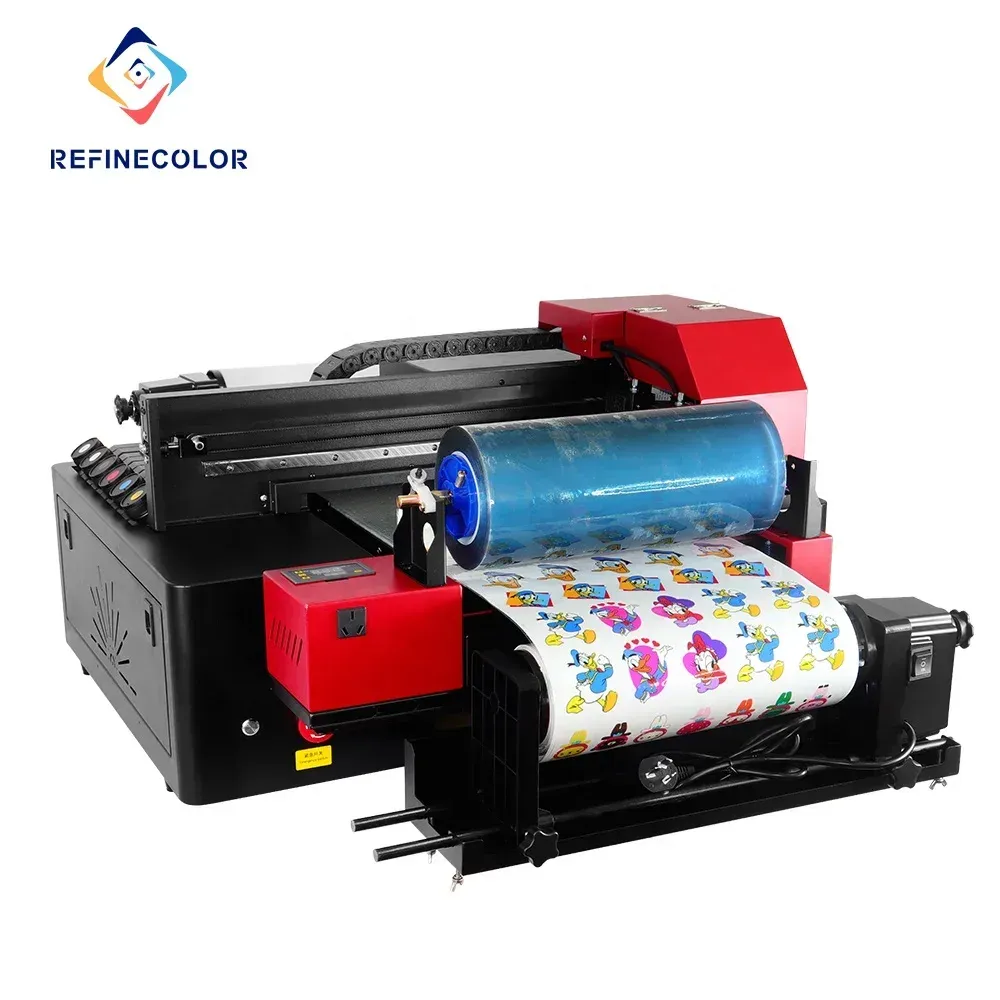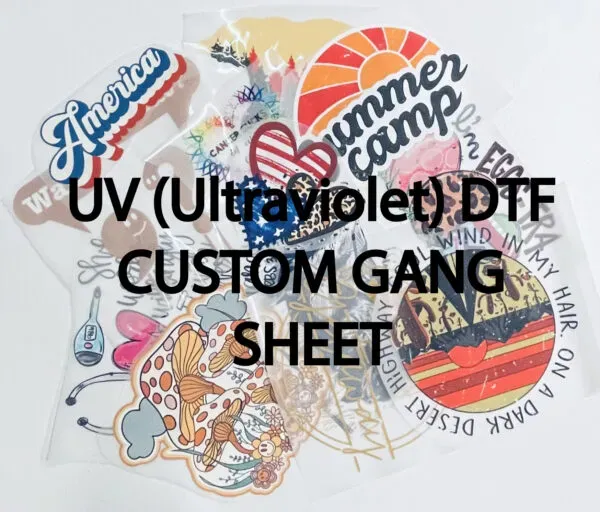UV DTF, which stands for Ultra Violet Direct to Film, is emerging as a groundbreaking technology in the printing landscape. This innovative printing method utilizes ultraviolet light to cure inks on a specially coated film, allowing for vibrant color reproduction and robust durability. As businesses seek more efficient and high-quality printing solutions, understanding the advantages of UV DTF becomes crucial. Among the benefits of UV DTF are its ability to print on diverse materials and its resistance to environmental wear, making it a go-to option for various industries. In this article, we’ll explore the UV DTF process in detail, highlighting how UV DTF works and its significant advantages in today’s competitive market.
Ultra Violet Direct to Film printing, commonly referred to as UV DTF, is revolutionizing how graphics are transferred onto different substrates. This process, which employs UV light technology, ensures that prints are not only colorful but also incredibly durable. With the printing industry continually evolving, terms like UV DTF printing and the advantages of UV DTF resonate among professionals who seek versatile and high-quality output. By integrating cutting-edge methodologies, the UV DTF process caters to a myriad of applications, showcasing its utility across various sectors. Join us as we delve into the unique benefits of UV DTF and how it stands out in a sea of printing solutions.
Understanding the UV DTF Process
The UV DTF process, or Ultra Violet Direct to Film printing, is a sophisticated method that has redefined the standards of modern printing. To begin this process, high-quality, durable inks are strategically printed onto a specialized film. The use of UV inks ensures that graphics are created with vibrant colors that catch the eye and maintain their integrity over time. Unlike traditional methods where inks might bleed or fade, the UV inks cure under ultraviolet light, solidifying almost instantly and setting the stage for the film to be transferred to a substrate.
Following the initial printing, the film undergoes a crucial step where it is exposed to UV light, which cures the inks onto the film. This curing process is not just about speed; it also enhances the bond between the ink and the substrate during the heat transfer phase. As the film is pressed onto various surfaces, whether they’re textiles, metals, or plastic, the vibrant designs are firmly adhered and resistant to daily wear and tear. By understanding how UV DTF printing works, businesses can appreciate the technology’s efficiency and precision, positioning it as a game-changer in the industry.
Key Advantages of UV DTF Printing
UV DTF printing offers a plethora of advantages that make it a preferred choice among businesses. One of the most significant benefits is the exceptional durability of the prints. Unlike conventional printing methods, UV DTF inks form a protective layer that resists scratches, fading, and other forms of damage. This quality is essential, especially for products like promotional merchandise and custom apparel, where long-lasting prints enhance customer satisfaction and brand loyalty.
Additionally, the versatility of UV DTF technology is another compelling advantage. It effortlessly prints on a wide range of materials, such as textiles, wood, and metals, opening up various application possibilities. Custom t-shirts, signage, and decorative items are just the beginning; the technology encourages creative exploration across different industries. By leveraging UV DTF’s capabilities, businesses can expand their product offerings and cater to diverse customer needs.
The Role of Color in UV DTF Printing
Color plays a pivotal role in UV DTF printing, where vibrant hues are a hallmark of the technology. UV DTF inks are designed to deliver richer and brighter colors compared to traditional methods. This is particularly important for businesses aiming to make an impression with their printed products—whether it’s a bold logo or an intricate graphic, the quality of color reproduction can greatly influence customer perception.
The broader color spectrum provided by UV DTF print technology means that designers have greater creative freedom to experiment with hues and gradients. When utilized effectively, this capability not only enhances the aesthetic appeal of products but also plays a critical role in branding and marketing. Quality prints that explode with color can help capture attention in a crowded market, making UV DTF printing an invaluable asset for companies aiming for standout visuals.
Eco-Friendly Options in UV DTF
As environmental concerns continue to rise, the printing industry has also made strides towards sustainability, with UV DTF being at the forefront. Many manufacturers offer eco-friendly water-based UV DTF inks that significantly reduce harmful emissions during the printing process. These inks’ water-based formulation not only minimizes toxicity but also addresses the growing demand from consumers for environmentally responsible products.
By opting for eco-friendly UV DTF inks, businesses not only contribute to sustainability efforts but also enhance their brand image. Clients increasingly prefer partners that prioritize the environment, and adopting UV DTF printing with sustainable practices can help businesses appeal to this conscientious consumer base. Therefore, integrating eco-friendly options into the UV DTF printing process can lead to not just positive environmental impacts, but also boost profitability and brand loyalty.
Automation and Efficiency in UV DTF Printing
The integration of automation into UV DTF printing processes has revolutionized production efficiency. Automated systems can significantly speed up printing operations while maintaining high standards of quality. With technology evolving, businesses are now able to produce high-quality prints at a faster rate, minimizing delays and making it possible to fulfill large orders reliably and efficiently.
Additionally, automation helps reduce labor costs as fewer manual interventions are needed. This shift allows staff to focus on creative aspects of the business rather than routine tasks, enhancing overall productivity. By embracing automation within the UV DTF printing landscape, companies find themselves better equipped to meet market demands while benefiting from cost savings and improved output.
Future Innovations in UV DTF Technology
The future of UV DTF technology is promising, with ongoing innovations poised to further elevate its capabilities. From advancements in printer design to the incorporation of artificial intelligence, these improvements are set to enhance not only the quality of prints but also the efficiency of operations. For instance, smarter systems could allow for more precise ink application and error minimization, leading to flawless prints on the first attempt.
Moreover, as materials evolve, UV DTF technology will undoubtedly adapt to accommodate new substrates, expanding the range of applications available to businesses. These innovations signify a shift toward enhanced capabilities in producing intricate designs and bespoke items that meet the unique needs of various industries. By staying at the forefront of technology, companies harness the power of UV DTF to meet the demands of an ever-evolving market, ensuring continued relevance and competitiveness.
Frequently Asked Questions
What is UV DTF printing and how does it work?
UV DTF printing, or Ultra Violet Direct to Film printing, utilizes UV light to cure ink on a specially coated film before transferring the design to various substrates. The process includes designing an image on film, curing the ink with UV light for durability, and then using heat and pressure to transfer the image onto materials like fabric or plastic.
What are the main advantages of UV DTF printing?
The advantages of UV DTF printing include exceptional durability against wear and tear, versatility in printing on various materials, vibrant color reproduction with a broad spectrum, eco-friendly options with water-based inks, and efficiency through integrated automation that increases production speed while lowering costs.
How does the UV DTF process ensure the durability of prints?
The UV DTF process ensures durability by curing inks instantly with UV light, which solidifies the ink and creates a robust layer. This high-quality format is resistant to scratches, fading, and other damage, making it ideal for promotional products and apparel that require longevity.
For what types of materials is UV DTF printing suitable?
UV DTF printing is suitable for a wide variety of materials including fabrics, plastics, metals, and more. This versatility allows businesses to use UV DTF technology for applications ranging from custom apparel to decorative signs, expanding creative possibilities in various sectors.
What eco-friendly options are available with UV DTF printing?
Many manufacturers now produce water-based UV DTF inks that reduce harmful emissions, making UV DTF printing a more eco-friendly option. These inks appeal to environmentally-conscious consumers and help businesses enhance their reputation by aligning with sustainable practices.
What considerations should businesses keep in mind when choosing UV DTF technology?
When considering UV DTF technology, businesses should evaluate initial investment costs for printers and materials, the necessary training for staff, and ongoing maintenance of equipment. Conducting research or small-scale testing can provide valuable insights before fully committing to UV DTF printing.
| Key Points | Description |
|---|---|
| Introduction to UV DTF Printing | UV DTF utilizes UV light to cure inks on coated film for vibrant, durable prints. |
| How UV DTF Works | Involves design printing, curing inks with UV light, and heat transfer to substrate. |
| Exceptional Durability | Inks resistant to scratching and fading, ensuring product longevity. |
| Versatility | Compatible with various substrates including fabrics, plastics and metals. |
| Vibrant Color Reproduction | Delivers bright, bold colors with a wider spectrum than traditional methods. |
| Eco-Friendly Options | Water-based inks available to reduce harmful emissions and enhance brand reputation. |
| Efficiency Through Automation | Advanced integrations streamline production, reduce labor costs, and enhance output. |
| Future of UV DTF Technology | Continuous advancements position UV DTF as a key player in the printing industry. |
| Considerations for Businesses | Factors such as costs and training must be evaluated for successful implementation. |
Summary
UV DTF is revolutionizing the printing industry with its innovative approach to graphic printing. This cutting-edge technology not only provides exceptional durability and vibrant color reproduction, but it also offers versatility that allows it to print on a wide range of substrates. As businesses look to enhance their product offerings, UV DTF stands out as a solution that meets the demands of contemporary markets while staying eco-friendly. With an eye toward future advancements, understanding UV DTF is essential for businesses aiming to remain competitive and responsive to customer needs.







